Measuring Carbon in Hawaii's Forests
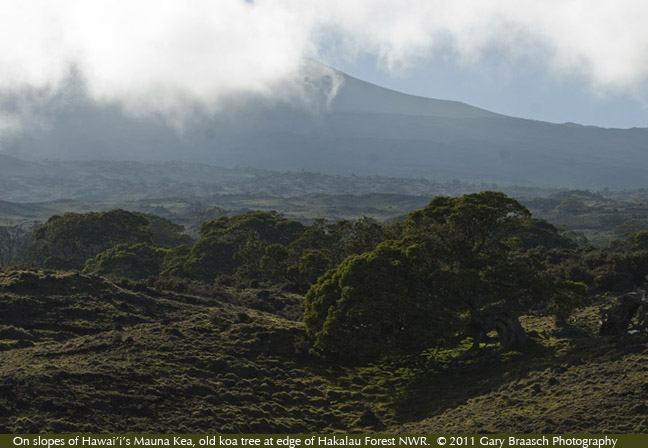
On the eastern slopes of Mauna Kea, Hawai'i, deforested, overgrazed and degraded land at about 1850 m (6000 ft) elevation gives way downslope to scattered giant koa and ohi'a trees and eventually a native Hawaiian montane forest. This forest was established as Hakalau Forest National Wildlife Refuge in 1985 to protect and manage endangered Hawaiian forest birds and their rain forest habitat. According to the USFWS, the 32,733-acre Hakalau Forest Unit supports a diversity of native birds and plants equaled by only one or two other areas in the State of Hawai'i. Since 1989, over 400,000 native trees have been planted to restore and expand the forest. Now the native forest and others nearby in the Hawai'i Experimental Tropical Forest (http://www.hetf.us/) are the site of scientific studies of how much carbon dioxide these forests take up and give off and how much carbon is stored in this ecosystem in wood, leaves, roots, coarse woody debris, and soil.
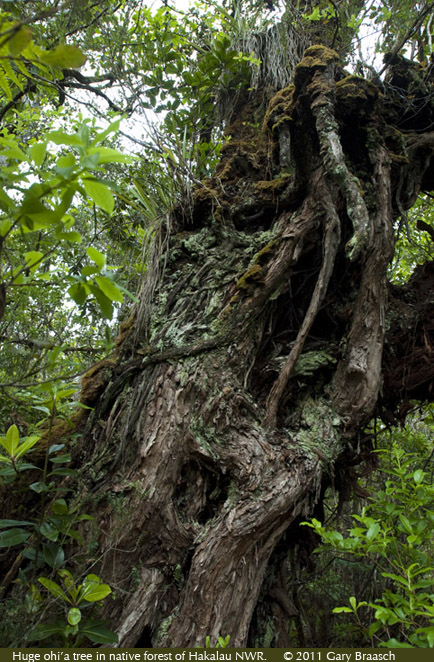
Hakalau Forest NWR contains some of the finest remaining stands of native montane rain forest in Hawai'i -- including many large native trees like ohi'a (Metrosideros polymorpha, seen here) and koa (Acacia koa), growing in the complex ecosystem protected by the refuge. A study begun in 2008, funded by the National Science Foundation, US Forest Service and the College of Tropical Agriculture and Human Resources, University of Hawaii at Manoa has identified and measured every tree in nine plots 20 meters (66 feet) on a side, and is measuring how much carbon dioxide is taken up and given off by these forests to understand how rising temperatures associated with global climate change will impact their ability to sequester (store over a long time) atmospheric carbon dioxide. Gary Braasch accompanied a three-man research team which descended into the forest to collect data at two of the study sites in Hakalau.
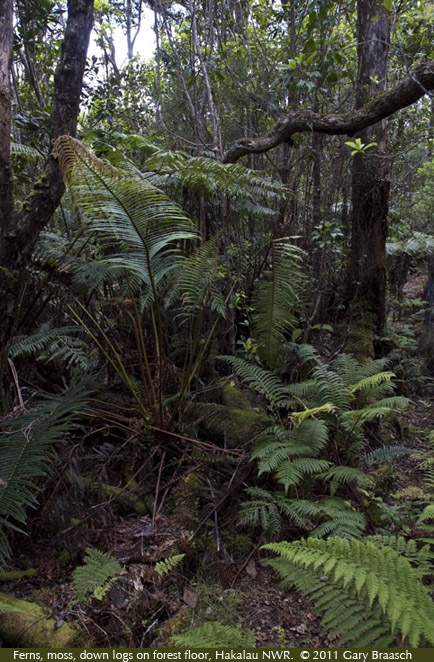
The understory of the native montane rainforest in Hakalau Forest NWR, Hawai'i, is rich in tree ferns, mosses and smaller trees like olapa (Cheirodendron trigynum) and kolea (Myrsine spp.). In the study being conducted in this forest and a nearby forest on Mauna Kea, Drs Creighton M. Litton, Christian P. Giardina and Susan E. Crow are quantifying the crucial role that tropical rainforest ecosystems play in controlling atmospheric CO2 concentrations, and investigating how carbon cycling in tropical rainforests will respond to rising temperature. The team and its field technicians have set up nine study plots at various elevations which represent a mean annual temperature gradient of 5°C, the higher plots being cooler than the lower ones. They are using the natural warming at lower elevations on a mountain to represent the expected global warming of 2-5°C over the next 100 years. "Temperature is a primary controlling factor for the development and function of all ecosystems," wrote Dr. Litton about the study, "so it is easy to imagine that changes in temperature will have large impacts on the structure and function of tropical rainforests."
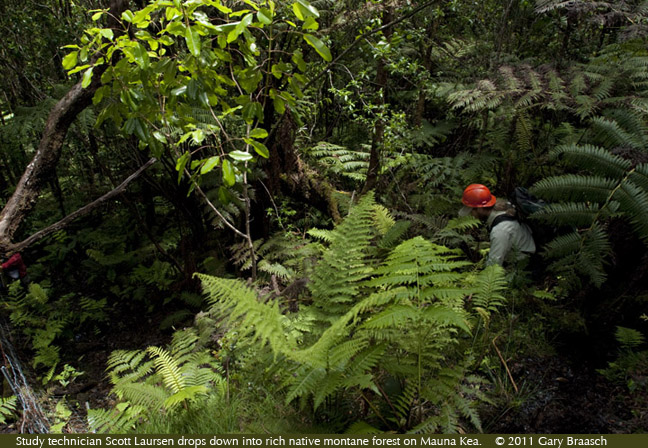
On a research trip in late March 2011, field team leader and research technician Scott Laursen drops down into a ravine on the steep slopes of Mauna Kea to reach a study area at 1600 m (5200 ft) in the native montane forest. The research program is testing two important hypotheses about the impact of rising temperatures on tropical wet forest carbon cycling, said principal investigator Dr. Creighton M. Litton of the University of Hawaii at Manoa: First that "rising temperatures will not impact total ecosystem carbon storage in forests because any losses in carbon stored in soils will be mitigated by increased carbon storage in trees;" and second, that soil carbon storage will be become even more important than carbon sequestered in aboveground live biomass (i.e., leaves and trunks). Writing in the College of Tropical Agriculture and Human Resources Research News Magazine (http://www.ctahr.hawaii.edu/site/downloads/crn/CTAHR_Research_News_Nov_09.pdf), Litton said that both hypotheses have "very important implications for how the carbon sink strength of forests will be altered by rising temperatures." This is crucial because forests around the world hold and absorb through photosynthesis a huge amount of carbon from the atmosphere, thereby providing an important reduction in atmospheric CO2 levels, and many scientists predict that climate warming will reduce the capacity of forests to play this important mitigating role.
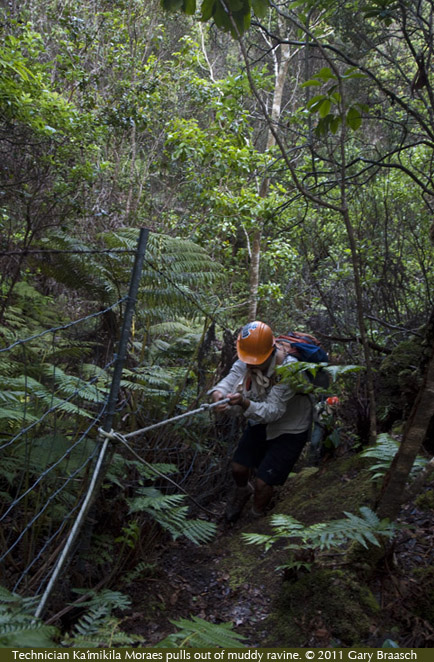
The elevation difference between the two plots visited on this trip on the slopes of Mauna Kea is about 150 meters (less than 500 ft) but the deep ravines, soggy bogs and rough volcanic terrain make travel difficult. Using a rope that had been tied in place previously, technician Ka'imikila Moraes hauls himself up out of a stream bed. The fence is one of many installed by the US Fish and Wildlife Service to exclude feral cattle and pigs, which are very destructive to the native forest.
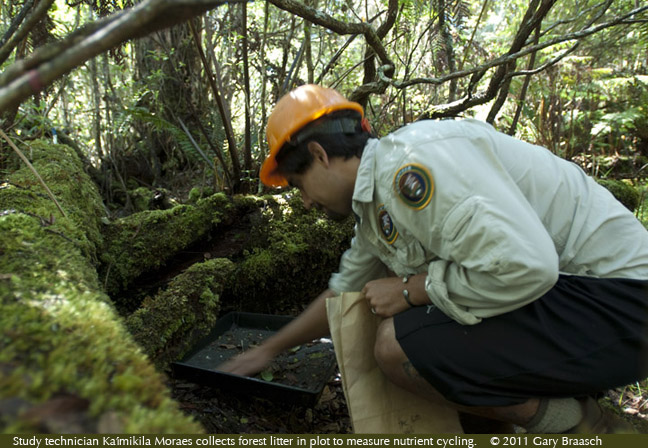
At a study plot, Ka'imikila Moraes collects leaves, twigs, and other forest litter which had fallen into a collecting tray (littertrap) since the last monthly survey of this area. Measuring and analyzing litterfall is one way to understand how much carbon moves from the living canopy to the rich soil, transferring nutrients and carbon. The nine 20-meter square study sites in the native forest of Mauna Kea are subdivided into 5 by 5 meter plots, each one of which has a litterfall tray and location for measuring the soil temperature and moisture, and the amount of carbon dioxide released by soil, known as soil respiration. Soil respiration is the largest source of CO2 from forest ecosystems to the atmosphere, making it a critical quantity to measure in determining forest carbon balance.
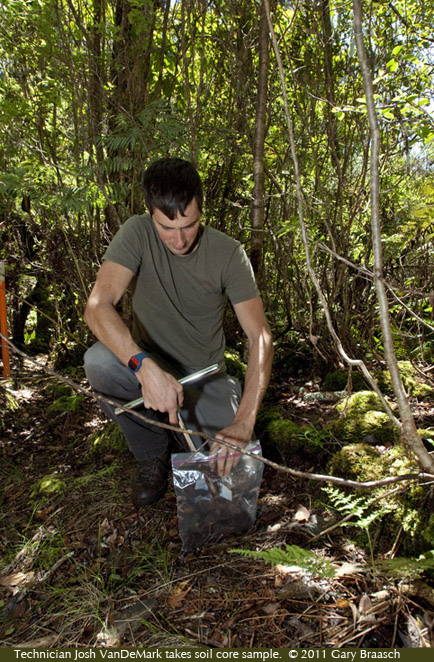
In a research plot on the richly forested slopes of Mauna Kea in Hakalau Forest NWR, Hawai'i, technician Josh VanDeMark collects soil samples. He has augered down into the soil in one of the 16 five-meter square plots at this location and collects the core of soil and forest duff for lab analysis of the carbon content in its roots, decomposing plants, microbes, algae, fungi and minerals.. Quantifying soil carbon storage is critical, as globally soils contain more carbon than aboveground vegetation and the atmosphere combined. As a result, quantifying how rising temperatures will impact soil carbon storage is crucial to predicting the future effects of CO2 and other global warming emissions.
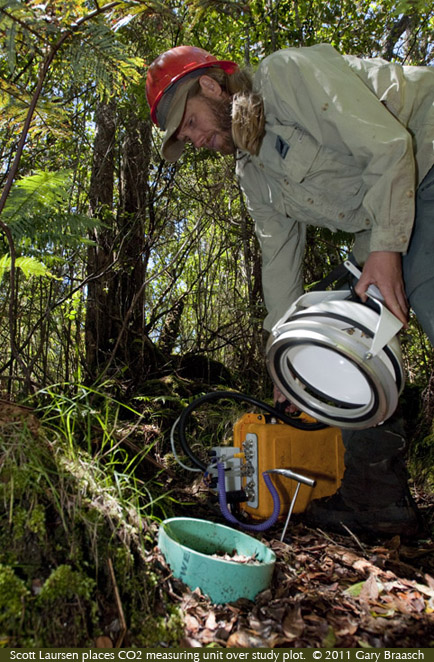
Team leader Scott Laursen prepares to measure soil-surface CO2 efflux (i.e., soil respiration; the flow of CO2 from soils to the atmosphere) in this study, a critical component of quantifying the role that forest ecosystems play in controlling atmospheric CO2 concentrations, and investigating how carbon cycling in tropical rainforests will respond to rising temperature. In addition to the basic tools of science -- notebooks, tape measures, collecting trays and bags, thermometers, etc. -- this study uses an automated and computerized machine (LI-8100A Automated Soil CO2 Flux System) which measures the amount of CO2 coming from a section of forest soil. Production of CO2 in the soil is from respiration of roots, insects and other invertebrates, microbes, algae and fungi during decomposition and nutrient transfer. This CO2 moves from areas of high concentrations in soil into the lower concentration in the atmosphere. Scott places the survey chamber of the LiCor 8100A Automated Soil CO2 Flux System over an 8 inch collar embedded in the forest floor. Two 1-1/2 minute measurements of CO2 coming from the soil within the collar are made by the machine at each location where the study team has installed the collars. The machine calculates soil CO2 flux by measuring the change in CO2 concentration over time inside of the chamber.
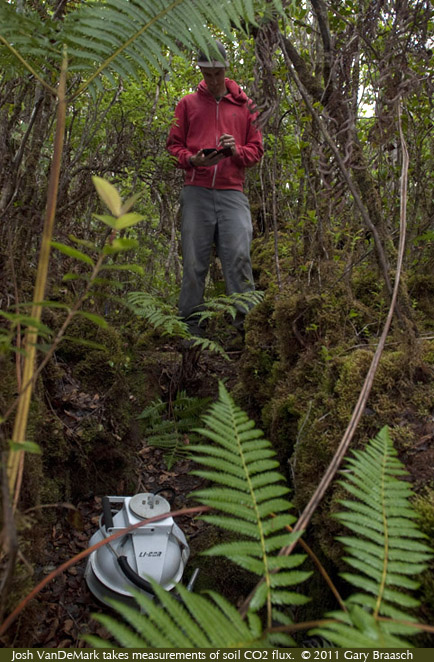
Standing back from the LiCor CO2 measuring chamber to avoid contaminating the reading with his own breath, technician Josh VanDeMark wirelessly monitors the readings of CO2 flux from a section of soil at another research site in the native montane forest of Mauna Kea. The soils in this forest vary in their temperature, moisture and biotic activity. The study aims, in the words of principal investigator Creighton M. Litton, to "build 'carbon budgets'" for the forest. "Much like a financial budget, building a carbon budget entails measuring all of the inputs of carbon into the system, how carbon is partitioned within the system, and the outputs of carbon from the system." Location of the study plots in similar forests but at various elevations is showing clear differences correlated with average temperature, giving clues to how forests will react and change due to global warming.
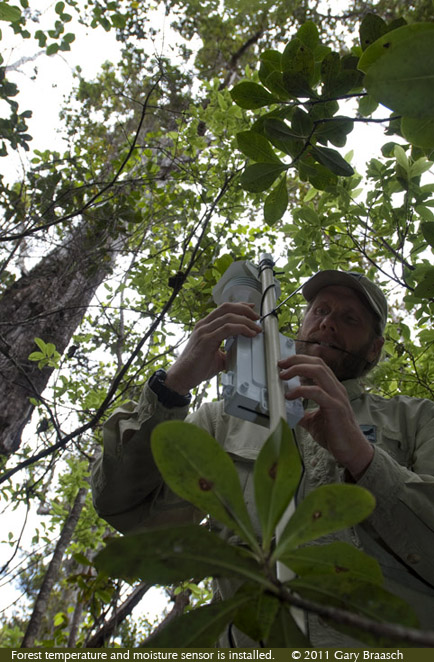
In a study plot at 1600 meters (5200 feet) elevation on the slopes of Mauna Kea, Hawai'i, forest research technician Scott Laursen installs a thermometer and moisture sensor which will record daily readings from the air and soil. There are nine of these micro-climate stations, one at each of the plots, and also three automated, state-of-the-art climate stations at the top, middle and bottom of the elevation range of the study.

A native tree fern unfurls in the Hakalau Forest NWR montane rainforest, site of a long term study begun in 2008 attempting to unravel the interrelationships among forest plants and soils, temperature and the role that ecological systems play in cycling carbon. As explained by study co-investigator Creighton Litton, "Atmospheric CO2 is fixed into an organic form during photosynthesis and this fixed carbon is used to grow new biomass and maintain
existing biomass. Eventually this carbon is returned to the atmosphere via ecosystem respiration, but much of it is stored in forests for hundreds to thousands of years as live and dead biomass, and soil organic matter. As such, terrestrial ecosystems play a crucial role in controlling atmospheric CO2 concentrations."
Quotes are from "Understanding and protecting Hawai'i's unique ecological heritage in the face of global change" by Creighton M. Litton, Assistant Professor, Department of Natural Resources and Environmental Management, University of Hawaii, in the November 2009 issue of the CTAHR Research News Magazine. The study was funded by the National Science Foundation; the USDA Forest Service, Institute of Pacific Islands Forestry, Pacific Southwest Research Station; and the College of Tropical Agriculture and Human Resources, University of Hawaii at Manoa. Please see study information at http://www.ctahr.hawaii.edu/nrem/research.org and related information about CO2 at http://www.worldviewofglobalwarming.org/pages/maunaloa.php
COPYRIGHT NOTICE:
Photography and text Copyright © 2005 - 2017 (and before) Gary Braasch All rights reserved. Use of photographs in any manner without permission is prohibited by US copyright law. Photography is available for license to publications and other uses. Please contact requestinformation@worldviewofglobalwarming.org. View more of Gary Braasch's photography here.


